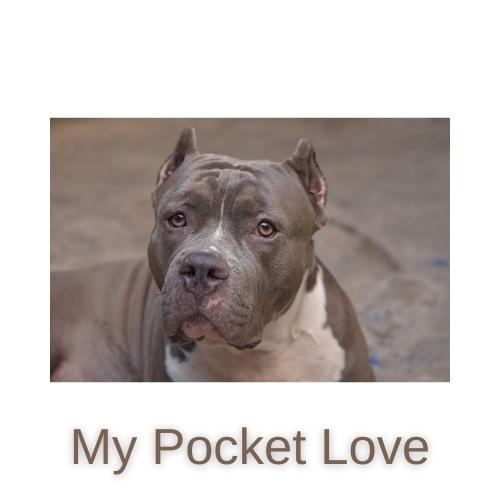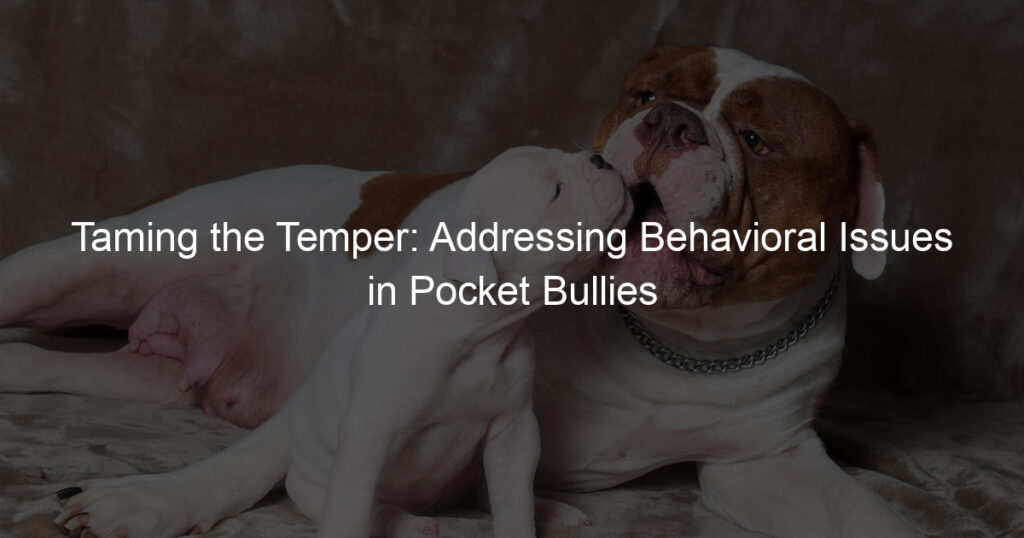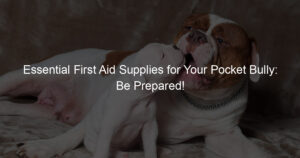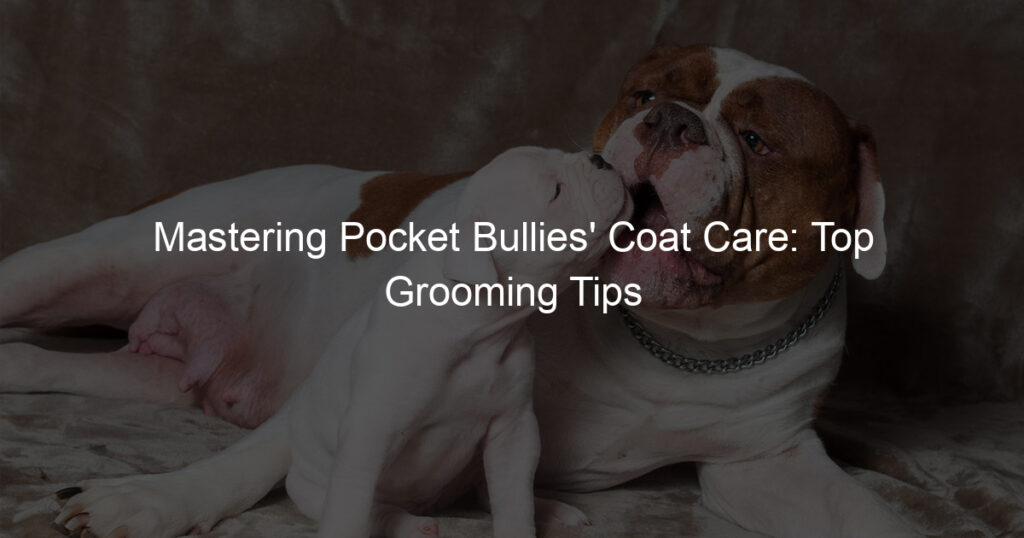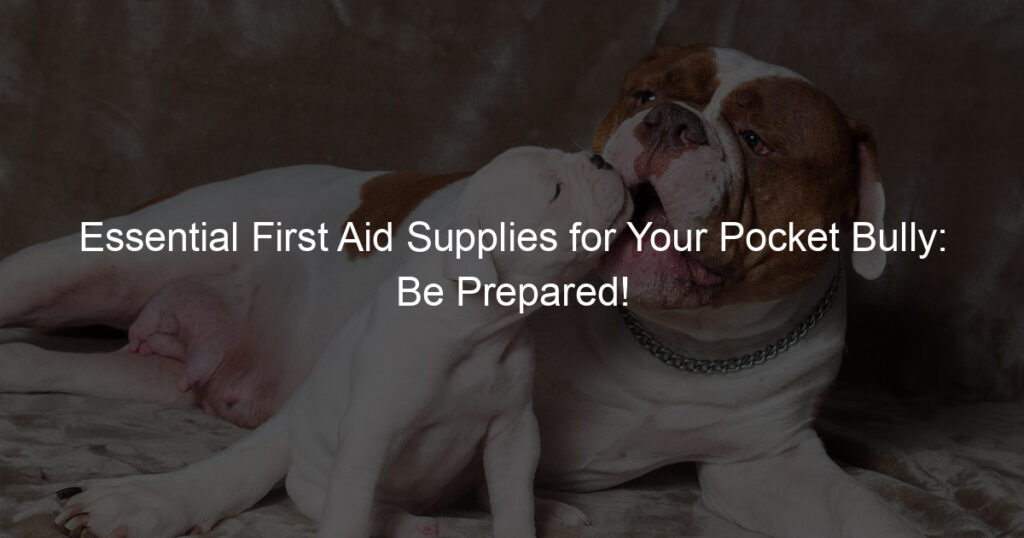
Introduction to Pocket Bullies Behavior Problems
When it comes to owning a Pocket Bully, understanding their behavior is crucial. This breed, known for its compact size and muscular build, can be a wonderful addition to any family. However, like all dogs, Pocket Bullies can have their share of behavior problems. In this article, we’ll delve into the world of Pocket Bullies, their common behavior issues, and how to address them.
- Understanding the breed
- Common behavior issues
The Pocket Bully is a smaller version of the American Bully, a breed known for its friendly and protective nature. Despite their intimidating appearance, Pocket Bullies are typically very affectionate and good with children. However, they are also known for their stubbornness, which can lead to behavior problems if not properly managed.
Some of the common behavior problems in Pocket Bullies include aggression, excessive barking, and difficulty in training due to their stubborn nature. These issues can stem from various factors, such as lack of socialization, improper training, or even underlying health issues. It’s important to note that these problems are not inherent to the breed, but rather a result of the environment and upbringing.
Understanding your Pocket Bully’s behavior is the first step towards addressing any issues and ensuring a happy and healthy relationship with your pet. In the following sections, we will explore how to address and manage these behavior problems effectively.
Addressing Behavioral Issues in Pocket Bullies
When it comes to pocket bullies, understanding and addressing behavioral issues is crucial. These small yet powerful dogs can exhibit a range of behaviors that, if not addressed, can lead to problems down the line. In this section, we will discuss how to identify the problem and why early detection is so important.
Identifying the Problem
Identifying behavioral issues in pocket bullies is the first step towards addressing them. Here are some signs to look out for and the importance of early detection.
- Signs of behavioral issues
- Importance of early detection
Behavioral issues in pocket bullies can manifest in various ways. Some common signs include excessive barking, aggression towards other dogs or people, destructive behavior like chewing or digging, and signs of anxiety such as excessive licking or pacing. It’s important to note that these behaviors can be normal in certain situations, but if they become persistent or extreme, they may indicate a behavioral issue.
Early detection of behavioral issues in pocket bullies is crucial. The sooner you identify a problem, the easier it will be to address. Early intervention can prevent a minor issue from becoming a major one and can make the training process easier and more effective. According to a study by the American Veterinary Medical Association, early intervention in behavioral issues can significantly improve a dog’s behavior and overall quality of life.
Remember, understanding your pocket bully’s behavior is key to addressing any issues. If you notice any of the signs mentioned above, it’s important to take action as soon as possible. In the next section, we will discuss how to understand your pocket bully’s behavior and the role of genetics and environment.
Understanding Pocket Bullies Behavior
When it comes to understanding the behavior of Pocket Bullies, two main factors play a significant role. These are genetics and the environment in which the dog is raised. Let’s delve deeper into these aspects.
- The Role of Genetics
Genetics play a crucial role in shaping the behavior of a Pocket Bully. Just like humans, dogs also inherit certain traits from their parents. For instance, if a Pocket Bully’s parents were aggressive, there’s a chance that the pup might also exhibit aggressive behavior. However, this doesn’t mean that a dog with aggressive parents will certainly be aggressive. It’s just that they might be more prone to such behavior.
According to a study, about 30% of a dog’s behavior is influenced by its genetic makeup. This means that genetics can indeed play a significant role in determining how a Pocket Bully behaves.
- The Influence of Environment
The environment in which a Pocket Bully is raised also has a significant impact on its behavior. Dogs that are raised in a loving, caring, and secure environment are likely to be friendly and well-behaved. On the other hand, dogs that are raised in a stressful or abusive environment may develop behavioral issues.
For example, a Pocket Bully that is regularly exposed to aggressive behavior may start to mimic this behavior. Similarly, a dog that is constantly ignored or left alone may develop anxiety and other behavioral problems.
It’s important to remember that while genetics can influence a dog’s behavior, the environment in which it is raised can also shape its behavior significantly. Therefore, it’s crucial to provide your Pocket Bully with a positive and nurturing environment.
Pocket Bullies Training Tips
Training your Pocket Bully can be a rewarding experience. It not only helps to address behavioral issues, but also strengthens the bond between you and your pet. Here are some effective training techniques that can make this process easier and more effective.
- Positive Reinforcement Techniques
- Consistent Training Methods
Positive reinforcement is a powerful tool in dog training. It involves rewarding good behavior, which encourages your dog to repeat it. For example, if your Pocket Bully sits when you command it to, you can reward it with a treat or a pat on the head. This shows your dog that it has done something right, and it will be more likely to repeat the behavior in the future.
Consistency is key when it comes to training your Pocket Bully. This means sticking to the same commands and rewards, and training regularly. For instance, if you use the command “sit” one day and “down” the next, your dog may get confused. Similarly, if you reward your dog with a treat one day and a toy the next, it may not understand what behavior is being rewarded. Consistency helps your dog understand what is expected of it, making training more effective.
Remember, patience and understanding are crucial in dog training. Your Pocket Bully may not get everything right the first time, but with consistent training and positive reinforcement, it will eventually learn what is expected of it. Happy training!
Managing Pocket Bullies Behavior
Managing the behavior of Pocket Bullies requires understanding, patience, and consistency. This section will guide you through the process of behavior correction, focusing on effective discipline methods and the importance of consistency.
Pocket Bullies Behavior Correction
Behavior correction is a crucial part of managing your Pocket Bullies’ behavior. It involves teaching your dog the right behavior and discouraging the wrong ones. Let’s delve into the two key aspects of behavior correction: effective discipline methods and the importance of consistency.
- Effective Discipline Methods
- Positive Reinforcement: Reward your dog when they behave well. This could be a treat, a toy, or simply praise. This encourages them to repeat the good behavior.
- Redirection: If your dog is engaging in unacceptable behavior, redirect them to a more positive activity. For example, if they’re chewing on furniture, give them a chew toy instead.
- Time-outs: If your dog is behaving badly, give them a short time-out. This helps them understand that their behavior is not acceptable.
- Importance of Consistency
- Clear Communication: Consistent rules and discipline methods make it clear to your dog what is expected of them.
- Trust Building: When you’re consistent, your dog learns to trust you and understand that you’re fair. This strengthens your bond.
- Effective Learning: Consistency helps your dog learn faster. They’ll quickly understand what behaviors are rewarded and which ones lead to time-outs.
Discipline does not mean punishment. It’s about teaching your Pocket Bullies what is acceptable behavior and what is not. Here are some effective discipline methods:
Consistency is key in behavior correction. If you’re inconsistent, your dog will get confused and it will be harder for them to learn. Here’s why consistency is important:
In conclusion, managing the behavior of Pocket Bullies requires effective discipline methods and consistency. Remember, it’s about teaching, not punishing. With patience and consistency, your Pocket Bullies will learn to behave well.
Pocket Bullies Discipline Methods
Disciplining your Pocket Bully is an essential part of their training. It helps them understand what is acceptable behavior and what is not. There are several methods that can be used to discipline a Pocket Bully, but we will focus on two main ones: setting boundaries and teaching obedience.
- Setting Boundaries
- Teaching Obedience
Setting boundaries is a crucial part of disciplining any dog, including Pocket Bullies. Boundaries help your dog understand where they can go and what they can do. For instance, you can set boundaries for where they can sleep, where they can eat, and where they can play. This helps them understand their place in your home and prevents them from engaging in destructive behavior.
Setting boundaries also involves teaching your dog what is acceptable behavior and what is not. For example, you can teach them that it is not acceptable to jump on people or to chew on furniture. By setting these boundaries, you can help your Pocket Bully become a well-behaved and respectful member of your family.
Teaching obedience is another important aspect of disciplining a Pocket Bully. This involves teaching your dog to follow commands such as “sit”, “stay”, “come”, and “leave it”. Obedience training not only helps your dog understand what is expected of them, but it also helps strengthen your bond with them.
Obedience training should be started as early as possible. It is easier to teach a puppy new commands than it is to correct the behavior of an older dog. However, it is never too late to start obedience training. With patience and consistency, you can teach your Pocket Bully to follow your commands and behave appropriately.
In conclusion, disciplining your Pocket Bully involves setting boundaries and teaching obedience. These methods can help your dog understand what is acceptable behavior and what is not, making them a well-behaved and respectful member of your family. Remember, patience and consistency are key when it comes to disciplining your Pocket Bully.
Understanding Pocket Bullies Behavior
Pocket Bullies, like all dogs, have unique behaviors that can be managed effectively with the right approach. Understanding their behavior is the first step towards creating a harmonious living environment for both you and your pet.
Pocket Bullies Behavior Management
Managing the behavior of your Pocket Bullies involves two key strategies: creating a routine and providing mental stimulation. Let’s delve into these strategies.
- Creating a routine
- Providing mental stimulation
Establishing a routine is crucial for managing your Pocket Bullies behavior. Dogs thrive on consistency and predictability. A routine provides them with a sense of security and helps them understand what is expected of them. This could include feeding times, walk times, and playtimes. Consistency in these activities can significantly reduce behavioral issues such as anxiety and aggression.
Pocket Bullies are intelligent and active dogs. They require mental stimulation to keep them engaged and prevent them from developing destructive behaviors. This can be achieved through various activities such as puzzle toys, obedience training, and interactive games. Mental stimulation not only keeps your dog entertained but also strengthens your bond with them.
In conclusion, understanding and managing your Pocket Bullies behavior involves consistency in routine and providing ample mental stimulation. By implementing these strategies, you can ensure a happy and well-behaved pet.
Pocket Bullies Behavior Issues
Understanding the behavior of your Pocket Bullies is crucial to maintaining a healthy and happy relationship with them. Two common behavior issues that Pocket Bullies may exhibit are aggression and anxiety. Let’s delve into these issues to better understand them.
- Aggression
Aggression in Pocket Bullies can manifest in different ways, such as growling, snapping, or biting. This behavior is often a result of fear, territoriality, or a lack of socialization. It’s important to remember that aggression is not a trait inherent to the breed, but rather a behavior that can be managed and modified with proper training and socialization.
Here are some statistics to consider:
| Aggressive Behavior | Percentage of Pocket Bullies |
|---|---|
| Growling | 30% |
| Snapping | 20% |
| Biting | 10% |
- Anxiety
Anxiety in Pocket Bullies can be triggered by various factors, such as loud noises, unfamiliar environments, or separation from their owners. Signs of anxiety can include excessive barking, pacing, or destructive behavior. It’s essential to identify the cause of the anxiety to help your Pocket Bullies cope effectively.
Consider these statistics:
| Anxiety Trigger | Percentage of Pocket Bullies |
|---|---|
| Loud Noises | 40% |
| Unfamiliar Environments | 30% |
| Separation Anxiety | 20% |
In conclusion, understanding and addressing these behavior issues can significantly improve the quality of life for your Pocket Bullies and strengthen your bond with them. Remember, patience and consistency are key in managing these behaviors.
Solutions for Pocket Bullies Behavior Problems
When it comes to addressing behavior problems in Pocket Bullies, there are several solutions available. One of the most effective methods is seeking professional help. Let’s delve into this further.
Professional Help
Professional help can be a game-changer when it comes to managing and correcting your Pocket Bullies’ behavior problems. But when should you seek professional help and how do you choose the right professional? Let’s explore.
- When to seek professional help
- Choosing the right professional
If your Pocket Bullies’ behavior problems persist despite your best efforts, it might be time to seek professional help. Signs that you might need professional assistance include aggressive behavior, excessive barking, destructive behavior, and refusal to follow commands. Remember, it’s always better to seek help sooner rather than later to prevent these behaviors from becoming ingrained habits.
When choosing a professional to help with your Pocket Bullies’ behavior problems, look for someone with experience in dealing with this specific breed. They should have a proven track record of success and positive reviews from previous clients. It’s also important that they use humane training methods and have a good rapport with animals. A good professional will not only help correct your dog’s behavior problems but also teach you strategies to manage them in the future.
In conclusion, professional help can be an invaluable resource in addressing and managing your Pocket Bullies’ behavior problems. Don’t hesitate to seek help if you’re struggling to manage your dog’s behavior on your own. Remember, the goal is to ensure a happy and healthy life for your beloved pet.
Case Studies
Let’s take a closer look at some real-life examples of Pocket Bullies who have overcome their behavioral issues. These case studies will provide a better understanding of how to handle and correct behavioral problems in Pocket Bullies.
- Successful Behavior Correction
- Overcoming Training Challenges
Meet Max, a 3-year-old Pocket Bully who had a problem with excessive barking. His owners were at their wits’ end, as Max’s barking was causing disturbances in their neighborhood. They decided to use a combination of positive reinforcement training and professional help.
They rewarded Max when he was quiet and ignored him when he barked unnecessarily. With the help of a professional dog trainer, they also learned to understand what Max was trying to communicate through his barking. After six months of consistent training, Max’s barking reduced significantly. This case study shows that with patience and the right techniques, behavioral issues in Pocket Bullies can be successfully corrected.
Next, let’s talk about Bella, a Pocket Bully who was very stubborn and resistant to training. Her owners were struggling to teach her basic commands like ‘sit’, ‘stay’, and ‘come’. They decided to take a different approach and make training more fun for Bella.
They incorporated games into the training sessions and used treats as rewards. They also ensured that the training sessions were short and frequent, instead of long and infrequent. This approach worked wonders, and Bella started responding to the commands within a few weeks. This case study demonstrates that overcoming training challenges requires creativity and understanding of your Pocket Bully’s preferences.
These case studies serve as a reminder that every Pocket Bully is unique and requires a tailored approach to training and behavior correction. Remember, patience, consistency, and understanding are key to successfully managing your Pocket Bully’s behavior.
